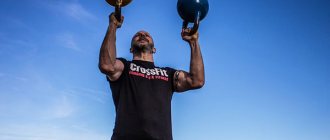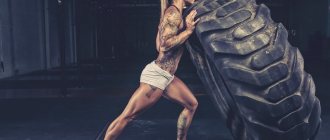What is CrossFit and what is it eaten with?
CrossFit as a form of physical activity appeared about 20 years ago in the United States of America and quickly gained popularity.
He came to Russia at the end of the 2000s. Many people have heard and know approximately what CrossFit is, but only in general terms. In this material we will talk in detail about all its intricacies, pros and cons, show the most popular exercises for beginners and give general training recommendations.
What is CrossFit, history of its appearance
CrossFit in English consists of two words:
- Cross – to cross, force;
- Fit – fitness.
Literally translated into Russian as intense fitness. CrossFit includes a system of high-intensity training, which is based on the following disciplines:
- Weightlifting;
- Weight-lifting;
- Gymnastics;
- Aerobics;
- Strongman exercises, etc.
Competitions are held in the CrossFit discipline, covering the whole world, including our country. And the Crossfit trademark was invented and registered in 2000 in the USA, where Greg Glassman and Lauren Jenai decided to create a large fitness empire and called it “CrossFit Inc.”
CrossFit is similar to regular circuit training - the exercises are constantly repeated, and to successfully complete it you need to complete a certain number of circles.
This type of training lasts from 15 to 60 minutes and not everyone is able to withstand it. The main goal of CrossFit is the comprehensive strengthening of the human body. It is popular in law enforcement units, combat sports and other areas of activity where the highest level of physical fitness is required.
Let's take a closer look at the elements and features of CrossFit.
Who is CrossFit for?
If your main goal is the harmonious development of your body, then CrossFit will definitely suit you. In the following cases, CrossFit will also be useful:
- Do you want to seriously pump up and get your body in shape;
- You love to compete, surpass yourself and get ahead of others. CrossFit as a team sport is popular in many countries around the world;
- Love sports and want to exercise every day;
- Many former professional athletes have switched to CrossFit and are trying themselves in this discipline;
- You've never played sports before, but you're serious about starting. A beginner in CrossFit can quickly become an amateur athlete, but before starting classes it is better to consult with a professional coach or instructor;
- You are a strong and purposeful person, you want to try and learn something new. CrossFit is a unique opportunity to improve yourself from both a physical and psychological point of view.
CrossFit is a universal thing, suitable for both men and women, both professional athletes and beginners or amateurs. The difference in training will only be in their intensity and working weights.
Also, if a person cannot perform an exercise, a replacement can be found. The better prepared the athlete, the higher the intensity of CrossFit training should be.
Let's look at the pros and cons of discipline.
CrossFit training program for beginners
If you're new to CrossFit, the best place to start is with an experienced trainer. But of course we will tell you how to take the first steps in functional training. So, a CrossFit training program for men who are just starting to train should include the following stages (after warming up):
- For your first workouts, choose any 3 sets of exercises. You shouldn’t immediately burden yourself with a large number of diverse trainings.
- Don’t forget to take a break between sets; for beginners, it’s optimal to rest for up to 3 minutes. This time is needed for the pulse to return to normal.
- Do not do workouts longer than 1 hour. You shouldn’t cross that fine line between health benefits and exhausting work.
- It is optimal to train 3 times a week. If you wish, you can do 4, but with breaks and with a duration of less than an hour.
- We recommend completing the initial CrossFit program for men for a month, and then moving on to more complex complexes.
Let's look at an approximate training program for beginners (taking into account 12 classes per month):
Monday.
1. Let's start by running 1 km at an average pace.
2. After running, take a break for 3-5 minutes, bring your pulse back to normal and begin the “Cindy Easy” complex – 5 push-ups, 5 squats and 5 sit-ups. Duration -15 minutes. Your task is to complete as many circles as possible.
3. You can end the training day with wide-grip push-ups from the floor 3*15 times
Wednesday.
1. We start with 20 minutes on a bicycle or exercise bike at an average pace.
2. Next, we perform in a circle: 10 push-ups, 10 squats, 10 sit-ups and 10 burpees (see picture below). Duration: 10 minutes.
3. Close-grip pull-ups and wide-grip push-ups 3*15 times.
Friday.
1. Run 2 km at an easy pace.
2. Rope climbing (with the help of legs) - 3 times, 5 climbs each.
3. Hammer hits on the tire - 3 sets of 90 seconds each.
4. Plank - 3 times for 60 seconds.
Pros and cons of CrossFit
Pros:
- The cardiovascular system is well pumped;
- Increases endurance;
- All muscle groups are comprehensively pumped during training;
- Metabolic processes improve;
- Sleep improves, you feel fresh and full of energy;
- Increases body flexibility and reduces the risk of injury;
- Combined with proper nutrition and a healthy lifestyle, CrossFit can be a quick option for losing weight;
- Many sports and strength qualities develop. After doing CrossFit regularly, you will be ready to run, jump, lift weights, etc.
Minuses:
- Since CrossFit is a universal thing, by doing it exclusively, you are unlikely to be the best in a certain discipline: run the fastest, jump higher than others, or lift the heaviest weights;
- CrossFit is quite dangerous because the level of intensity of training is often higher than in alternative sports. Follow the exercise technique to avoid injuries;
- The cardiovascular system is subjected to high load during CrossFit training, it is important not to overdo it;
Exercise technique
There are several types of abdominal sit-ups, the most common of which are: classic, using additional weights, V-sit-up (fold) and sit-up on an inclined bench. Let's talk in detail about the technique of performing each type of sitap.
Classic sit-up
It is this variety that interests us most, since most often in CrossFit complexes we perform the classic situp - its implementation does not require extreme mental concentration. The exercise is far from the most difficult, so it is easy for our brains to “switch” to it after performing another exercise. The classic sitap is performed as follows:
- Starting position: the athlete lies on his back, legs bent at the knees, arms straightened and lying above his head. The buttocks, lower back and upper back are pressed tightly to the floor. The feet are pressed firmly to the floor. If your feet start to lift off during the approach, try pressing your heels only into the floor and spreading your center of gravity like you would with a barbell squat.
- The athlete begins to move his body upward, exhaling at the same time. Our task is to rise using the force of the abdominal muscles, we try not to round our back, and try to reach our feet with our fingers. At the top point, the body should be located approximately at right angles to the floor.
- After touching your feet, smoothly begin to lower down while inhaling, making the movement quite quickly, but under control. Keep your arms straight above your head and touch them to the floor, then repeat the entire movement from the beginning.
Sitap with additional weights
This is a more advanced option for those athletes who can already perform the classic situp for a large number of repetitions without noticeable difficulties. It is most convenient to perform it with a disk or light dumbbells in outstretched arms. Of course, the weight of the weight should be moderate, do not try to set records in such exercises - you will not surprise anyone, but you can get an injury to the lumbar spine even if you follow the ideal technique and after a thorough warm-up
- Starting position: the athlete is positioned as in a classic situp, but holds the disc in straight arms approximately at the level of the lower chest.
- Simultaneously with lifting your torso, you need to push the disc up a little, accompanying this whole process with a powerful exhalation. At the highest point of the amplitude, the disc should be located above the head, and not in front of the chest, so the deltoid muscles, especially the anterior bundle, are also involved in the movement. In this case, the movement of the arms should not be of a pressing nature, we simply “direct” the disc upward, the triceps are not involved in the exercise, and the arms should not bend at the elbows.
- Smoothly lower your body down while at the same time returning the disc to chest level.
V-sitap (book)
© Mihai Blanaru — stock.adobe.com
The fold is also considered a kind of sitap. The movement is carried out simultaneously with the body and legs, which makes the exercise more explosive and increases the load on the abs, while the emphasis is on its lower part.
- The athlete lies down on the floor, the body is fully extended, arms are straight behind the head, all muscles are relaxed.
- You need to start doing a sit-up, while at the same time pulling your legs up, trying to reach your feet or the bottom of your shins with your hands. The movement is accompanied by exhalation. We try not to bend our legs at the knees, as this greatly simplifies the task.
- Begin to lower your body and legs down, feeling the stretch in your abdominal muscles. At the bottom point, a short pause is made, the body is fully straightened, as in the starting position.
Sit-up on an incline bench
© Nicholas Piccillo - stock.adobe.com
At first glance, this exercise is visually very similar to crunches while lying on an incline bench. The difference is that during the sit-up we keep our back vertically straight without bending the lower back, but when doing crunches the athlete somewhat rounds the thoracic spine in order to tighten the upper abs more. In addition, in most cases, when doing crunches, the athlete does not lower the body completely down onto the bench and works in a shortened amplitude, not allowing the muscles to relax at the lower and upper points; when doing sit-ups, we lower ourselves completely down onto the bench after each repetition and perform each repetition in full amplitude.
- Starting position: the athlete sits on an inclined bench, clinging to the stops with his feet, his arms are straightened and laid back.
- We begin to move the body upward, contracting the abdominal muscles without bending the lower back. At the top point you should be positioned at right angles to the machine. As you move, move your hands forward slightly to touch your feet.
- Smoothly lower your body down until it touches the bench. Lower yourself completely, relax all your muscles, and perform one more repetition.
Contraindications to CrossFit
There are many contraindications for every sport. Before starting training, it is highly recommended to visit a specialist doctor who is familiar with your sores and can advise and warn against troubles.
Contraindications:
- Injuries of the musculoskeletal system;
- Problems with the central nervous system;
- Diseases of the cardiovascular system;
- Digestive problems;
- Infectious diseases;
- Diseases of the genitourinary system;
- Contraindicated for women during pregnancy and lactation.
Even if you don’t have any ailments for which CrossFit is contraindicated, this does not mean that your body will immediately be able to withstand enormous loads.
If you decide to practice for the first time, the advice and supervision of a professional is simply necessary. Create a training program, learn the technique of performing basic exercises. Gradually increase the load over time. Only in this case can you avoid injuries and illnesses.
Complex No. 2
- 5 sumo deadlift
- 10 overhead squats
- 15 pull-ups (kipping)
- 20 jerk pulls
- 25 jumps on a pedestal
Challenge: maximum number of laps in 20 minutes
How to do it:
The sumo deadlift is performed from the position: legs slightly wider than shoulders, barbell on the floor, hands holding the barbell with a narrow grip. We perform the deadlift with a straight back by straightening the legs, after which the bar is pulled up to the chin.
Overhead squats are performed with a barbell overhead. The requirement for the exercise is that during a squat, the pelvis drops below the knee line.
You can do any pull-ups. The main thing is that the chin at the top point is higher than the bar. Broaches are performed similarly to the 1st complex. When jumping on the stand, fully straighten your legs on the stand.
Complex No. 4
- Raising the barbell to the chest in a squat position
- Pull-ups
- Jumping on a stand
- Deadlift
Objective: complete in the shortest possible time. We make three circles: 21-15-9, i.e. in the first circle we do all the exercises 21 times, on the second circle we do everything 15 times, and in the third we do everything 9 times.
How to perform: weights for deadlifts and cleans are selected individually, depending on the athlete’s preparedness.
During the squat chest lift, the barbell is on the floor. We jerk the barbell to the chest and then do 1 front squat. After this, the barbell returns to the floor and the exercise is done all over again.
We pull ourselves up dirty, with kipping. When jumping onto a pedestal, we make sure that the legs are straightened on the pedestal. When performing a deadlift, make sure that your back is straight, and at the top point we bring your shoulders back.
Try, train and become stronger!
In contact with









